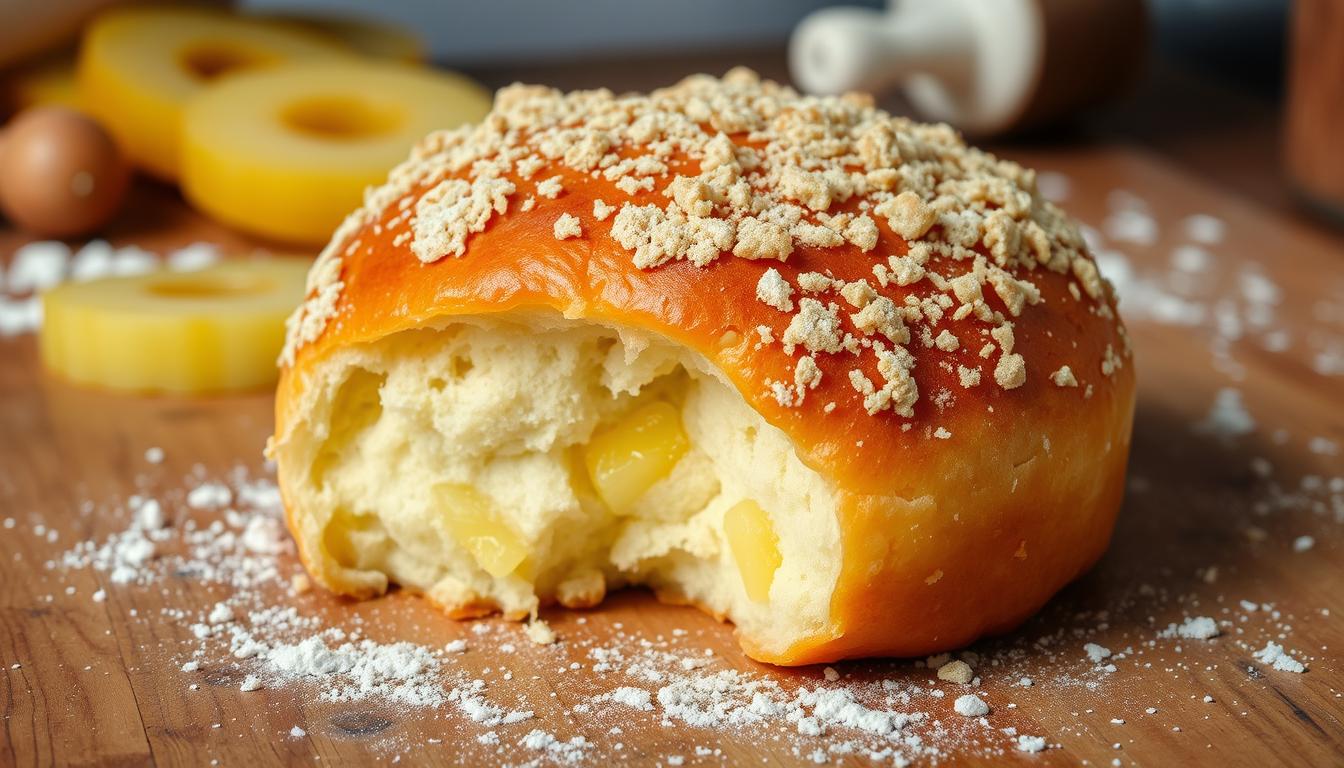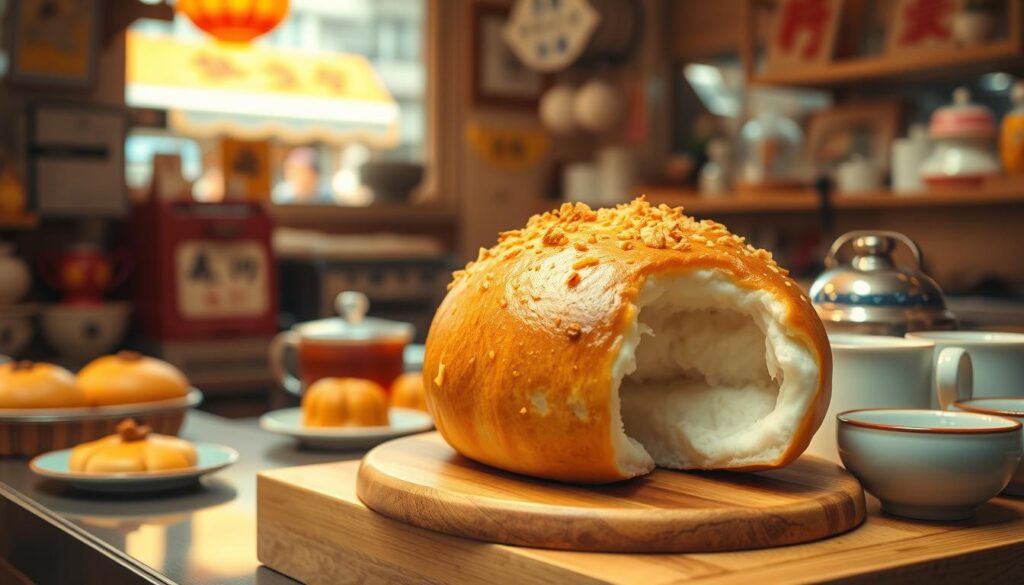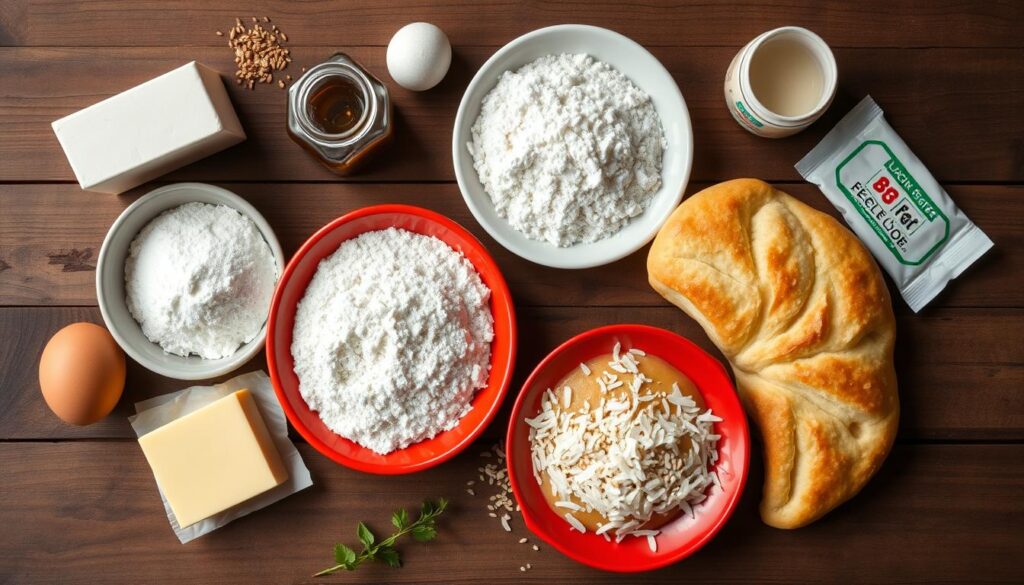The first time I tried a pineapple buns in San Francisco’s Chinatown, it was magical. The golden-brown top was crispy, and the inside was soft and fluffy. This homemade bolo bao recipe brings back that special moment.
Hong Kong pastry is more than just ingredients. It’s about tradition, memories, and love in every bite. The pineapple buns, or bolo bao, don’t have real pineapple. Their top looks like pineapple skin.
Whether you’re an experienced baker or just starting, this recipe will help you make authentic Hong Kong buns at home. You’ll turn simple ingredients into a tasty pastry with a story to tell.
Key Takeaways
- Pineapple buns are a classic Hong Kong bakery staple
- No actual pineapple is used in the recipe
- The unique crackly topping defines this pastry
- Homemade bolo bao can rival professional bakery quality
- This recipe is accessible for home bakers of all skill levels
Understanding Bolo Bao: A Hong Kong Bakery Classic
Explore the world of bolo bao, a beloved Chinese pastry in Hong Kong bakeries. It’s more than just bread; it’s a journey through Chinese culture.
Bolo bao started in Shanghai. Now, it’s a favorite in Chinese bakeries worldwide, especially in Hong Kong.
History and Cultural Significance
Bolo bao has deep roots in Chinese culture. In traditional bakeries, these buns are a link to childhood and family.
- Originated in Shanghai in the early 20th century
- Spread rapidly through Hong Kong bakeries
- Became a beloved street food and breakfast item
Why It’s Called a Pineapple Bun
Bolo bao doesn’t have pineapple. Its name comes from its crackled top, like a pineapple’s skin. This makes it stand out among other pastries.
“A bolo bao is not just a bun, it’s a piece of culinary art that tells a story of cultural heritage.”
Traditional vs Modern Variations
Old recipes used lard and custard powder. Now, bakers try new things like butter and vanilla. They keep the bolo bao’s spirit but add new tastes.
| Traditional Ingredients | Modern Ingredients |
|---|---|
| Lard | Butter |
| Custard Powder | Vanilla Extract |
| Basic Flour | Specialized Flour Blends |
Whether you love food or baking, learning about bolo bao’s history will make you appreciate it more. It’s a true Hong Kong bakery classic.
Essential Ingredients for Authentic Bolo Bao
To make perfect bolo bao, you need top-notch ingredients. Your journey to delicious Hong Kong-style treats begins with the right ingredients.
Dough Ingredients
- 3 cups organic all-purpose flour (386g)
- 1/2 cup organic cane sugar
- 1 packet active dry yeast (2 1/2 tsp)
- 2 teaspoons baking powder
- 1/2 cup unsweetened plant-based milk
- 2 tablespoons water
- 2 tablespoons unsalted vegan butter (melted)
- Pinch of salt
Topping Components
- 1 cup flour (113g)
- 3 tablespoons organic cane sugar
- 1/2 teaspoon baking powder
- 1/3 cup melted vegan butter
- 1/4 teaspoon turmeric powder (for color)
Pro tip: Using high-quality ingredients like organic flour and fresh yeast can significantly improve your bolo bao’s texture and taste.
“The secret to great bolo bao lies in the quality of your ingredients and the love you put into making them.” – Traditional Hong Kong Baker
Nutrition insights for your bolo bao per serving:
- Total Calories: 417 kcal
- Carbohydrates: 70g
- Protein: 8g
- Fat: 12g
By carefully choosing and measuring each ingredient, you’ll make authentic, tasty bolo bao. It will be just like the ones from traditional Hong Kong bakeries.
The Secret of Tangzhong: Key to Soft, Fluffy Buns
The tangzhong technique is a game-changer in Chinese baking. It turns regular bread into a special treat. This method, used in Asian bakeries, has changed home baking forever.
Learning the tangzhong technique lets you make bread that’s incredibly soft and fluffy. It stays fresh for longer. The secret is a simple pre-cooking step that changes how flour absorbs moisture.
How to Make Perfect Tangzhong
Creating perfect tangzhong needs precision and patience. Here’s how to master this Chinese baking tip:
- Mix 2 tablespoons of flour with 1/3 cup of water
- Heat the mixture over low heat
- Stir constantly until it thickens
- Reach the ideal temperature of 65°C (149°F)
Why Tangzhong Makes Better Bread
The science behind tangzhong is fascinating. Pre-cooking a small flour and liquid mixture creates a gel. This gel:
- Keeps the bread moist
- Makes the bread softer
- Extends how long the bread stays fresh
- Creates a tender crumb
Temperature Control Tips
| Stage | Temperature | Duration |
|---|---|---|
| Tangzhong Preparation | 65°C (149°F) | 3-5 minutes |
| Initial Dough Mixing | Room Temperature | 2-3 minutes |
| First Proofing | Warm Environment | 1.5 hours |
| Baking | 375°F (190°C) | 20 minutes |
Pro tip: Keeping the temperature consistent is crucial for that perfect, fluffy bread texture every time.
Pineapple Buns Recipe: Step-by-Step Instructions
Making homemade pineapple buns is a fun journey into Chinese pastry making. This bolo bao recipe needs precision and patience for the perfect taste and texture. We’ll guide you through each step to master these tasty treats.
For your bolo bao recipe, you’ll make two main parts: the bread dough and the crispy topping. Here’s what you’ll need:
Bread Dough Ingredients
- 300g all-purpose flour
- 38g sugar
- 4g active dry yeast
- 4g salt
- 10g milk powder
- 60g egg liquid
- 160g milk
Milk Crust Topping Ingredients
- 50g butter
- 50g powdered sugar
- 25g egg liquid
- 5g milk powder
- 100g low-gluten flour
The secret to great homemade pineapple buns is in the prep. Start by warming the milk to 110°F to 120°F. Gentle kneading is crucial – knead the dough for 10-15 minutes until it’s smooth and elastic.
“The magic of bolo bao is in the details of preparation and patience.” – Traditional Chinese Baker
Your dough needs two fermentation periods. The first proofing takes 1-2 hours, making the dough double in size. After shaping, let the buns proof for another 45 minutes.
Baking Specifications
- Baking Temperature:
- Top heat: 190°C (375°F)
- Bottom heat: 180°C (355°F)
- Baking Time: 15 minutes
- Yield: Approximately 12 buns
Pro tip for Chinese pastry making: Chill your milk crust dough for 15-20 minutes before applying it to the buns. This helps create that signature crackled top that makes pineapple buns so distinctive.
Each bun has about 310 calories and offers a delightful mix of textures – soft bread beneath a crispy, sweet topping. Your homemade pineapple buns are now ready to be enjoyed!
Making the Signature Crispy Topping
Making the perfect bolo bao topping is an art. It turns an ordinary bun into a culinary masterpiece. The pineapple bun crust is what makes this Hong Kong bakery classic special. It gives it its iconic crackle pattern and irresistible texture.
Achieving the Perfect Crackle Pattern
The signature crackle pattern is more than just a visual delight. It’s a crucial element of the bolo bao’s charm. Follow these key steps:
- Roll out the topping dough between two sheets of plastic
- Aim for a circular shape of 3.5 to 3.75 inches in diameter
- Keep the dough thin and evenly spread
- Score the surface in a distinct criss-cross pattern
Proper Topping Consistency
The secret to an exceptional pineapple bun crust lies in its ingredients and preparation. Here’s a breakdown of the perfect topping mixture:
| Ingredient | Quantity | Purpose |
|---|---|---|
| Melted Butter | ¼ cup | Provides richness |
| Granulated Sugar | ⅔ cup | Creates sweet crackle |
| Egg Yolk | 1 large | Adds binding and color |
| All-Purpose Flour | 1 cup | Provides structure |
Color and Texture Guide
The ideal bolo bao topping should have a golden-brown hue. It should have a delicate, crisp surface. Brush the topping with egg wash before baking to enhance its crackling effect and color. Pro tip: Bake at 350°F for about 20 minutes to achieve the perfect finish.
“The magic of bolo bao is in its crackling topping – crisp on the outside, tender underneath.” – Hong Kong Bakery Master
Proofing and Shaping Techniques
Mastering bread proofing methods is key to perfect bolo bao. The secret to soft, pillowy Chinese buns is in dough fermentation and shaping.
Timing and temperature are crucial when working with bolo bao dough. Instant yeast can cut fermentation time in half. The best temperature for yeast is 120-130°F (49-54°C), creating the perfect dough environment.
“Proofing is where the magic happens in bread making” – Artisan Baker
Proofing Steps for Perfect Bolo Bao
- First Rise: Let dough rest 60-90 minutes until it doubles in size
- Divide dough into uniform portions (2.5-2.75 ounces each)
- Shape into smooth balls using gentle Chinese bun techniques
- Second Proofing: Let buns expand 30-45 minutes
Overnight Proofing Method
- Place dough in greased bowl
- Cover with plastic wrap
- Refrigerate overnight
- Remove and shape before final proofing
For consistent results, try these bread proofing methods. The dough should rise to 1.5 times its original size. This makes light and airy buns, just like authentic bolo bao.
Proofing Environment Recommendations
| Proofing Factor | Recommended Conditions |
|---|---|
| Temperature | 70-75°F (21-24°C) |
| Humidity | 75-80% |
| Rise Time | 60-90 minutes |
| Final Dough Volume Increase | 1.5x original size |
Remember, patience is key to perfecting bolo bao. Practice these techniques, and you’ll soon make bakery-worthy Chinese buns at home.
Baking Tips for Golden-Brown Perfection
Mastering bolo bao baking needs precision and knowing how temperature and timing affect your pineapple bun’s look. Getting that golden-brown crust is all about paying attention to the little things.
Professional bakers know it’s not just about the recipe. Your pineapple bun oven techniques can turn a good bun into an amazing one.
Temperature and Timing Guidelines
When baking your bolo bao, keep these key points in mind:
- Preheat your oven to 350°F (175°C)
- Bake for about 20-25 minutes
- Rotate the baking sheet halfway for even browning
Visual Doneness Indicators
Know when your bolo bao is done by looking for these signs:
- It turns a rich, deep golden-brown on top
- It sounds hollow when tapped on the bottom
- Edges are slightly crisp but not burnt
“Baking is an art where temperature tells the story of flavor and texture.”
| Baking Parameter | Recommended Value |
|---|---|
| Oven Temperature | 350°F (175°C) |
| Baking Time | 20-25 minutes |
| Batch Size | 6 buns per baking sheet |
Remember, practice makes perfect with bolo bao baking tips. Each batch will help you get better at your pineapple bun oven techniques. You’ll develop a knack for baking excellence.
Storage and Reheating Methods
Keeping your homemade bolo bao fresh is key. It’s all about the right storage and reheating. This way, you keep the pastry’s crispy top and soft inside just right.
For keeping your Chinese pastries fresh for a short time, here’s what to do:
- Store bolo bao in an airtight container at room temperature
- Keep for maximum 2-3 days to ensure optimal freshness
- Place a clean kitchen towel inside the container to absorb excess moisture
Reheating pineapple buns is best done in the oven. Don’t use the microwave. It can make the crispy top soggy and ruin the texture.
| Storage Method | Duration | Recommended Technique |
|---|---|---|
| Room Temperature | 2-3 days | Airtight container |
| Refrigerator | Up to 7 days | Sealed plastic bag |
| Freezer | Up to 3 months | Wrapped individually |
Freezing is great for long-term storage of your Chinese pastries. Wrap each bolo bao individually in plastic wrap before placing in a freezer-safe container.
“The secret to maintaining bolo bao’s delicious quality is proper storage and gentle reheating.” – Traditional Hong Kong Baker
Reheating frozen bolo bao takes some time. Preheat your oven to 350°F. Warm the buns for 8-10 minutes. This method brings back the crispy topping and a warm, soft inside.
Troubleshooting Common Baking Issues
Mastering bolo bao means knowing how to solve common baking problems. Every baker faces challenges when making these tasty pineapple buns. But, learning how to fix these issues can make baking much better.
- Dense buns often result from incorrect proofing techniques
- Pale crusts might indicate suboptimal oven temperature
- Soft toppings typically stem from ingredient ratio mistakes
Yeast activation is key for bolo bao success. The best rising temperature is between 85°F to 95°F. This ensures the dough develops well. If your kitchen is cooler, you might need to double the rising time or find a warmer spot.
“Precision in baking is an art form that requires patience and practice”
Here are some tips for solving common problems:
- Check yeast quality and expiration date
- Maintain precise ingredient measurements
- Control proofing environment temperature
- Avoid overworking dough or topping mixture
If your topping spreads too much, chill it longer before baking. An instant-read thermometer can help ensure your buns reach the perfect internal temperature of 190°F.
Conclusion
Learning to make homemade bolo bao turns your kitchen into a real Chinese bakery. It takes practice and the right techniques to get the texture and taste right. You’ll need patience, to understand how ingredients work together, and to try new things.
Getting better at making pineapple buns comes from paying attention and trying again. Each time you make them, you learn something new about the dough, toppings, and flavors. Just like professional bakers, who often test their recipes many times.
Enjoy the cultural depth of each bolo bao you make. These pastries are more than a recipe; they carry generations of tradition. By baking at home, you connect with a long history of baking. And you get to make amazing treats. Serve your bolo bao with milk tea for a truly special experience.



